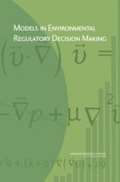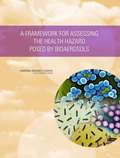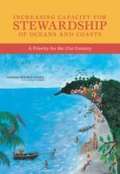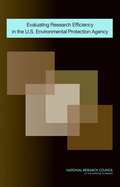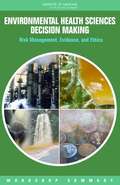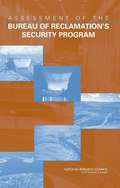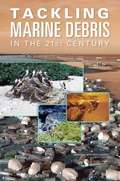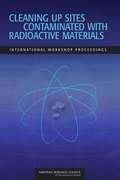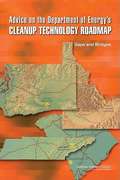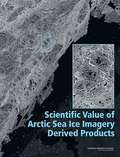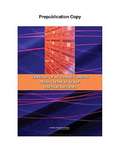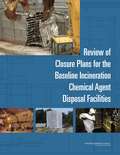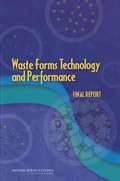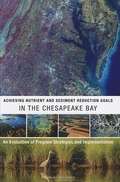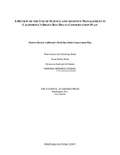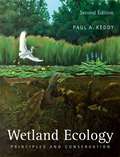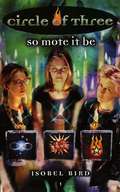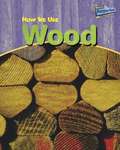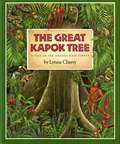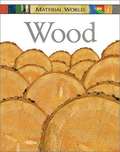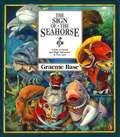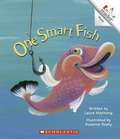- Table View
- List View
Models in Environmental Regulatory Decision Making
by National Research Council of the National AcademiesMany regulations issued by the U.S. Environmental Protection Agency (EPA) are based on the results of computer models. Models help EPA explain environmental phenomena in settings where direct observations are limited or unavailable, and anticipate the effects of agency policies on the environment, human health and the economy. Given the critical role played by models, the EPA asked the National Research Council to assess scientific issues related to the agency's selection and use of models in its decisions. The book recommends a series of guidelines and principles for improving agency models and decision-making processes. The centerpiece of the book's recommended vision is a life-cycle approach to model evaluation which includes peer review, corroboration of results, and other activities. This will enhance the agency's ability to respond to requirements from a 2001 law on information quality and improve policy development and implementation.
A Framework for Assessing the Health Hazard Posed by Bioaerosols
by National Research Council of the National AcademiesBiological warfare agent (BWA) detectors are designed to provide alerts to military personnel of the presence of dangerous biological agents. Detecting such agents promptly makes it possible to minimize contamination and personnel exposure and initiate early treatment. It is also important, though, that detectors not raise an alarm when the situation does not warrant it. The question considered in this book is whether Agent-Containing Particles per Liter of Air (ACPLA) is an appropriate unit of measure for use in the evaluation of aerosol detectors and whether a better, alternative measure can be developed. The book finds that ACPLA alone cannot determine whether a health threat exists. In order to be useful and comparable across all biological agents and detection systems, measurements must ultimately be related to health hazard. A Framework for Assessing the Health Hazard Posed by Bioaerosols outlines the possibility of a more complex, but more useful measurement framework that makes it possible to evaluate relative hazard by including agent identity and activity, particle size, and infectious dose.
Increasing Capacity for Stewardship of Oceans and Coast: A Priority for the 21st Century
by National Research Council of the National AcademiesMarine environments support the livelihoods, economies, and quality of life for communities around the world. But growth of coastal populations and increasing demands on marine resources are putting the future of ocean and coastal resources at risk through impacts such as overfishing, wetland drainage, climate change, and pollution of coastal waters. Given these demands, it is vital to build capacity--the people, the institutions, and technology and tools--needed to manage ocean resources. Unfortunately, many capacity building efforts focus on specific projects rather than on capacity building as goal unto itself, resulting in activities that are not funded or sustained past the typically short project lifetime. This book finds that the most successful capacity-building efforts meet the needs of a specific locale or region based on periodic assessments and include plans to maintain and expand capacity after the project ends. The report recommends ways that governments and organizations can help strengthen marine protection and management capacity, including conducting periodic program assessments, making plans to sustain funding, and developing leadership and political will. The book was produced at the request of Gordon and Betty Moore Foundation, the President's Circle of the National Academies, the David and Lucile Packard Foundation, the National Oceanic and Atmospheric Administration, the National Science Foundation, the Marisla Foundation, and the Curtis and Edith Munson Foundation.
Evaluating Research Efficiency in the U.S. Environmental Protection Agency
by National Research Council of the National AcademiesA new book from the National Research Council recommends changes in how the federal government evaluates the efficiency of research at EPA and other agencies. Assessing efficiency should be considered only one part of gauging a program's quality, relevance, and effectiveness. The efficiency of research processes and that of investments should be evaluated using different approaches. Investment efficiency should examine whether an agency's R&D portfolio, including the budget, is relevant, of high quality, matches the agency's strategic plan. These evaluations require panels of experts. In contrast, process efficiency should focus on "inputs" (the people, funds, and facilities dedicated to research) and "outputs" (the services, grants, publications, monitoring, and new techniques produced by research), as well as their timelines and should be evaluated using quantitative measures. The committee recommends that the efficiency of EPA's research programs be evaluated according to the same standards used at other agencies. To ensure this, OMB should train and oversee its budget examiners so that the PART questionnaire is implemented consistently and equitably across agencies.
Environmental Health Sciences Decision Making: Risk Management, Evidence, and Ethics
by Institute of MedicineEnvironmental health decision making can be a complex undertaking, as there is the need to navigate and find balance among three core elements: science, policy, and the needs of the American public. Policy makers often grapple with how to make appropriate decisions when the research is uncertain. The challenge for the policy maker is to make the right decision with the best available data in a transparent process. The Environmental Health Sciences Decision Making workshop, the first in a series, was convened to inform the Roundtable on Environmental Health Sciences, Research, and Medicine on emerging issues in risk management, "weight of evidence," and ethics that influence environmental health decision making. The workshop, summarized in this volume, included an overview of the principles underlying decision making, the role of evidence and challenges for vulnerable populations, and ethical issues of conflict of interest, scientific integrity, and transparency. The workshop engaged science interest groups, industry, government, and the academic sector.
Assessment Of The Bureau Of Reclamation's Security Program
by National Research Council of the National AcademiesThe water impounded behind a dam can be used to generate power and to provide water for drinking, irrigation, commerce, industry, and recreation. However, if a dam fails, the water that would be unleashed has the energy and power to cause mass destruction downstream, killing and injuring people and destroying property, agriculture, industry, and local and regional economies. The U.S. Bureau of Reclamation (Reclamation) is responsible for managing and operating some of this nation’s largest and most critical dams. The failure of one or more of these dams as the result of a malicious act would come with little warning and a limited time for evacuation. In the years since the 9/11 attacks, Reclamation has invested significant resources to establish and build a security program. Reclamation is now ready to evaluate the results of these efforts and determine how best to move forward to develop a security program that is robust and sustainable. This book assesses Reclamation’s security program and determines its level of preparedness to deter, respond to, and recover from malicious acts to its physical infrastructure and to the people who use and manage it.
Tackling Marine Debris In The 21st Century
by National Research Council of the National AcademiesMarine debris from ships and other ocean-based sources-including trash and lost fishing gear-contributes to the spoiling of beaches, fouling of surface waters and the seafloor, and harm to marine animals, among other effects. Unfortunately, international conventions and domestic laws intended to control marine debris have not been successful, in part because the laws, as written, provide little incentive to change behavior. This book identifies ways to reduce waste, improve waste disposal at ports, and strengthen the regulatory framework toward a goal of zero waste discharge into the marine environment. Progress will depend on a commitment to sustained funding and appropriate institutional support. The Interagency Marine Debris Coordinating Committee should, through planning and prioritization, target research to understand the sources, fates, and impacts of marine debris. It should support the establishment of scalable and statistically rigorous protocols that allow monitoring at a variety of temporal and spatial scales. These protocols should contain evaluative metrics that allow assessment of progress in marine debris mitigation. The United States, through leadership in the international arena, should provide technical assistance and support for the establishment of additional monitoring and research programs worldwide.
Cleaning Up Sites Contaminated With Radioactive Materials: International Workshop Proceedings
by National Research Council of the National AcademiesThis publication features papers presented at the Workshop on Cleaning Up Sites Contaminated with Radioactive Materials, held in Moscow in June 2007. This activity was organized by the National Academies in cooperation with the Russian Academy of Sciences and with funding provided by the Russell Family Foundation. The workshop was designed to promote exchanges of information on specific contaminated sites in Russia and elsewhere and to stimulate greater attention to the severity of the problems and the urgent need to clean up sites of concern to the local and international communities.
Advice on the Department of Energy's CLEANUP TECHNOLOGY ROADMAP: Gaps and Bridges
by National Research Council of the National AcademiesBeginning with the Manhattan Project and continuing through the Cold War, the United States government constructed and operated a massive industrial complex to produce and test nuclear weapons and related technologies. When the Cold War ended, most of this complex was shut down permanently or placed on standby, and the United States government began a costly, long-term effort to clean up the materials, wastes, and environmental contamination resulting from its nuclear materials production. In 1989, Congress created the Office of Environmental Management (EM) within the Department of Energy (DOE) to manage this cleanup effort. Although EM has already made substantial progress, the scope of EM's future cleanup work is enormous. Advice on the Department of Energy's Cleanup Technology Roadmap: Gaps and Bridges provides advice to support the development of a cleanup technology roadmap for EM. The book identifies existing technology gaps and their priorities, strategic opportunities to leverage needed research and development programs with other organizations, needed core capabilities, and infrastructure at national laboratories and EM sites that should be maintained, all of which are necessary to accomplish EM's mission.
Scientific Value of Arctic Sea Ice Imagery Derived Products
by National Research Council of the National AcademiesDuring the 1990s, a government program brought together environmental scientists and members of the intelligence community to consider how classified assets and data could be applied to further the understanding of environmental change. As part of the Medea program, collection of overhead classified imagery of sea ice at four sites around the Arctic basin was initiated in 1999, and two additional sites were added in 2005. Collection of images during the summer months at these six locations has continued until the present day. Several hundred unclassified images with a nominal resolution of 1 meter have been derived from the classified images collected at the 6 Arctic sites. To assist in the process of making the unclassified derived imagery more widely useful, the National Research Council reviewed the derived images and considered their potential uses for scientific research. In this book, we explore the importance of sea ice in the Arctic and illustrate the types of information--often unique in its detail--that the derived images could contribute to the scientific discussion.
Disposal of Activated Carbon from Chemical Agent Disposal Facilities
by National Research Council of the National AcademiesFor the last two decades, the United States has been destroying its entire stockpile of chemical agents. At the facilities where these agents are being destroyed, effluent gas streams pass through large activated carbon filters before venting to ensure that any residual trace vapors of chemical agents and other pollutants do not escape into the atmosphere in exceedance of regulatory limits. All the carbon will have to be disposed of for final closure of these facilities to take place. In March 2008, the Chemical Materials Agency asked the National Research Council to study, evaluate, and recommend the best methods for proper and safe disposal of the used carbon from the operational disposal facilities. This volume examines various approaches to handling carbon waste streams from the four operating chemical agent disposal facilities. The approaches that will be used at each facility will ultimately be chosen bearing in mind local regulatory practices, facility design and operations, and the characteristics of agent inventories, along with other factors such as public involvement regarding facility operations.
Review of Closure Plans for the Baseline Incineration Chemical Agent Disposal Facilities
by National Research Council of the National AcademiesThis book responds to a request by the director of the U.S. Army Chemical Materials Agency (CMA) for the National Research Council to examine and evaluate the ongoing planning for closure of the four currently operational baseline incineration chemical agent disposal facilities and the closure of a related testing facility. The book evaluates the closure planning process as well as some aspects of closure operations that are taking place while the facilities are still disposing of agent. These facilities are located in Anniston, Alabama; Pine Bluff, Arkansas; Tooele, Utah; and Umatilla, Oregon. They are designated by the acronyms ANCDF, PBCDF, TOCDF, and UMCDF, respectively. Although the facilities all use the same technology and are in many ways identical, each has a particular set of challenges.
Waste Forms Technology and Performance: Final Report
by The National Academy of SciencesThe Department of Energy's Office of Environmental Management (DOE-EM) is responsible for cleaning up radioactive waste and environmental contamination resulting from five decades of nuclear weapons production and testing. A major focus of this program involves the retrieval, processing, and immobilization of waste into stable, solid waste forms for disposal. Waste Forms Technology and Performance, a report requested by DOE-EM, examines requirements for waste form technology and performance in the cleanup program. The report provides information to DOE-EM to support improvements in methods for processing waste and selecting and fabricating waste forms. Waste Forms Technology and Performanceplaces particular emphasis on processing technologies for high-level radioactive waste, DOE's most expensive and arguably most difficult cleanup challenge. The report's key messages are presented in ten findings and one recommendation.
Achieving Nutrient and Sediment Reduction Goals in the Chesapeake Bay: An Evaluation of Program Strategies and Implementation
by The National Academy of SciencesThe Chesapeake Bay is North America's largest and most biologically diverse estuary, as well as an important commercial and recreational resource. However, excessive amounts of nitrogen, phosphorus, and sediment from human activities and land development have disrupted the ecosystem, causing harmful algae blooms, degraded habitats, and diminished populations of many species of fish and shellfish. In 1983, the Chesapeake Bay Program (CBP) was established, based on a cooperative partnership among the U. S. Environmental Protection Agency (EPA), the state of Maryland, and the commonwealths of Pennsylvania and Virginia, and the District of Columbia, to address the extent, complexity, and sources of pollutants entering the Bay. In 2008, the CBP launched a series of initiatives to increase the transparency of the program and heighten its accountability and in 2009 an executive order injected new energy into the restoration. In addition, as part of the effect to improve the pace of progress and increase accountability in the Bay restoration, a two-year milestone strategy was introduced aimed at reducing overall pollution in the Bay by focusing on incremental, short-term commitments from each of the Bay jurisdictions. The National Research Council (NRC) established the Committee on the Evaluation of Chesapeake Bay Program Implementation for Nutrient Reduction in Improve Water Quality in 2009 in response to a request from the EPA. The committee was charged to assess the framework used by the states and the CBP for tracking nutrient and sediment control practices that are implemented in the Chesapeake Bay watershed and to evaluate the two-year milestone strategy. The committee was also to assess existing adaptive management strategies and to recommend improvements that could help CBP to meet its nutrient and sediment reduction goals. The committee did not attempt to identify every possible strategy that could be implemented but instead focused on approaches that are not being implemented to their full potential or that may have substantial, unrealized potential in the Bay watershed. Because many of these strategies have policy or societal implications that could not be fully evaluated by the committee, the strategies are not prioritized but are offered to encourage further consideration and exploration among the CBP partners and stakeholders.
California's Draft Bay Delta Conservation Plan
by The National Academy of SciencesThe San Francisco Bay Delta Estuary is a large, complex estuarine ecosystem in California. It has been substantially altered by dikes, levees, channelization, pumps, human development, introduced species, dams on its tributary streams and contaminants. The Delta supplies water from the state's wetter northern regions to the drier southern regions and also serves as habitat for many species, some of which are threatened and endangered. The restoration of water exacerbated tensions over water allocation in recent years, and have led to various attempts to develop comprehensive plans to provide reliable water supplies and to protect the ecosystem. One of these plans is the Bay Delta Conservation Plan (BDCP). The report, A Review of the Use of Science and Adaptive Management in California's Draft Bay Delta Conservation Plan,determines that the plan is incomplete in a number of important areas and takes this opportunity to identify key scientific and structural gaps that, if addressed, could lead to a more successful and comprehensive final BDCP. The plan is missing the type of structure usually associated with current planning methods in which the goals and objectives are specified, alternative measure for achieving the objectives are introduced and analyzed, and a course of action in identified based on analytical optimization of economic, social, and environmental factors. Yet the panel underscores the importance of a credible and a robust BDCP in addressing the various water management problems that beset the Delta. A stronger, more complete, and more scientifically credible BDCP that effectively integrates and utilizes science could indeed pave the way toward the next generation of solutions to California's chronic water problems.
Wetland Ecology
by Paul A. KeddyRichly illustrated and packed with numerous examples, this unique global perspective introduces wetland ecology from basic principles to advanced applications. Thoroughly revised and reorganised, this new edition of this prize-winning textbook begins with underlying causal factors, before moving on to more advanced concepts that add depth and context. Each chapter begins with an explanation of the basic principles covered, illustrated with clear examples. More difficult concepts and exceptions are introduced only once the general principle is well-established. Key principles are now discussed at the beginning of the book, and in order of relative importance, enabling students to understand the most important material without wading through complex theory. New chapters on wetland restoration and wetland services draw upon practical examples from around the world, providing a global context, and a new chapter on research will be particularly relevant to the advanced student planning their own studies.
Circle of Three #1: So Mote It Be
by Isobel BirdSpecial feature: This PerfectBound e-book contains Part One of an interview with author Isobel Bird. With this ribbon I do bindMy heart to yours and yours to mine.Love, I call you, come to me,As is my will, so mote it be. Kate cast the love spell with results unforeseen.She cannot stop it by herself, but the book of spells tells her of two strangers who can help her -- if only she can find them.
How We Use Wood
by Chris OxladeHow We Use Wood will give you answers to these and many other questions: Why is wood a good material for building boats? How do we get paper from wood? Why we use wood to make drain pipes?
The Great Kapok Tree: A Tale of the Amazon Rain Forest
by Lynne CherryExhausted from his labors, a man chopping down a great kapok tree in the Brazilian rain forest puts down his ax, and, as he sleeps, the animals who live in the tree plead with him not to destroy their world. "This modern fable with its urgent message contains an abundance of information. "--The Horn Book
Slowly Slowly Slowly Said the Sloth
by Eric CarleSlowly, slowly, slowly . . . that's how the sloth lives. He hangs upside-down from the branch of a tree, night and day, in the sun and in the rain, while the other animals of the rain forest rush past him. "Why are you so slow? Why are you so quiet? Why are you so lazy?" the others ask the sloth. And, after a long, long, long time, the sloth finally tells them! Set in the lush world of the tropical rain forest, this original picture book is an exquisite showcase of Eric Carle's colorful collage art-with a meaningful message: Slow down! Take time to enjoy your world.
Wood
by Claire LlewellynSoft, warm, heavy, slimy. . . which of these words describe metal or plastic, rubber or wood? This series covers them all -- with big colorful photographs, "Fascinating Facts, " and easy "Try This" experiments that introduce simple science concepts in a fun and engaging way, and show how each material is produced, transformed for everyday use, and impacts the environment. That paper plate in the lunchroom will never seem the same again once readers really get to know their Material World!
The Sign of the Seahorse: A Tale of Greed and High Adventure in Two Acts
by Graeme BaseThe inhabitants of a coral reef are threatened when a shady real estate deal started by the greedy Groper floods their area with poisonous waste.
Recreational Vehicle Cookbook
by Charlotte DawsonIn her RECREATIONAL VEHICLE COOKBOOK Charlotte Dawson has collected some of the favorite recipes of fascinating people she and her husband have met on their travels throughout the United States. While most of the recipes lend themselves beautifully to recreational cooking because of their simplicity they are far from commonplace. Molasses pie, Sabattus stew, swamp cabbage, corn custard, Johnny Johnson's chili concoction and recipes from the Ladies' Auxiliary of the Hatteras Volunteer Fire Department are only a sampling of the many, many unusual recipes you will find between theese covers. Mrs. Dawson has organized her cookbook into regions of America. Represented are New England, the Middle Atlantic States, Southeast, Pacific Northwest and the Southwest. Also included are a host of recipes that are delicious just about everywhere.
One Smart Fish
by Laura ManivongA child tries to catch a fish using such bait as hot dog meat, cookie dough, and spaghetti.
